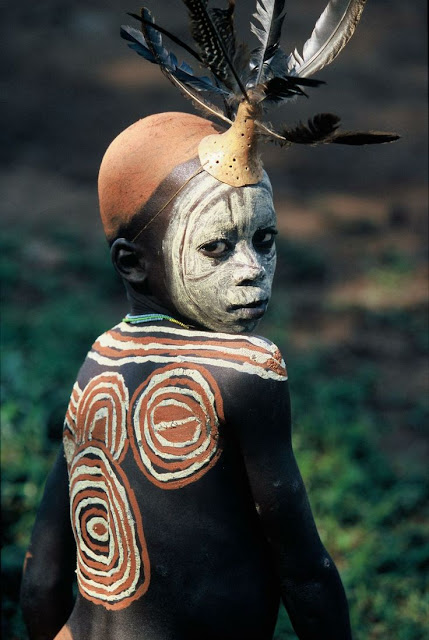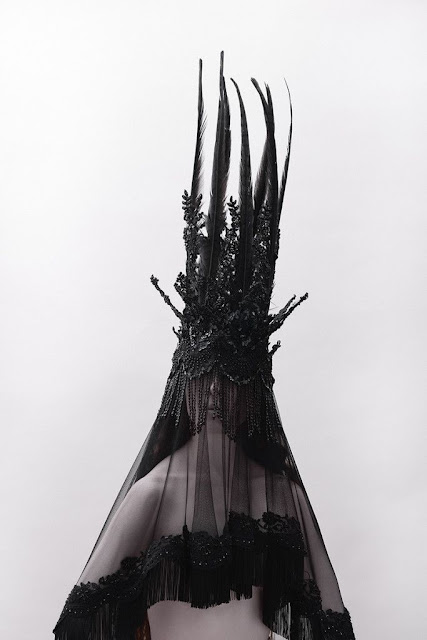 |
| Assyrian styles of headresses |
The practice of covering the face and hair continued as commonplace, for men and women, alike, for many centuries. During this time, both men and women wore various types of veils for purposes ranging from modesty to religious preference to symbols of wealth or education.
During the Anglo Saxon / Norman era (circa 1175), most of the head of women were covered in what was called a "wimple". The wimple is a cloth head-dress that covers the head, the neck - the the chin - and both sides of the face.
It took about 300 years, but when the Tudor period (1485) came into being, styles changed and hoods became popular, replacing the wimple and veil. Below are two fine art examples of the Tudor style headdress, as you can see, the veil is now at the back of the head (top) and the hair is allowed to be exposed.
In the Middle Ages, it was common for both European and Byzantine married women to cover their hair, and not their face, utilizing many styles of wimple, kerchiefs and headscarves. The veil or wimple was typically worn when one was outside the home.
 |
| Above: Another medieval "butterfly" headpiece. |
 |
| Jackie Kennedy at JFK's funeral |
Recently, a local pastor and I were chatting about the fact that I haven't been to church in a long time as I am conflicted about to what church I belong. She was very poignant in asking me, "Do you like the mysticism of Catholicism?" and I had to answer that I did. I love the smell of incense and the pomp and circumstance, and with this notion, I distinctly conjured the image of the many women who chose to wear veils to mass, right in my home town.
In lieu of wearing a mask, as a means of hiding one's identity, women who plan an illicit rendezvous' with a lover or acting otherwise in a surreptitious manner, wore veils to cover the face and hair.
Today, one may still wear any form of a veil or kerchief (also called a bandanna or a "doo-rag") to protect the face from sun or wind which may damage delicate skin and/or hair. In a "retro" sense, kerchiefs were frequently worn to cover hair rollers, or fussy hairstyles or hair that was not washed. It was not uncommon for women to wear them in, or out of the home.
 |
| cosmopolitan.com |
 |
 |
| retro - 17 magazine |
The Bridal Veil
"In the 19th century, wedding veils came to symbolize the woman's virginity and modesty.
The tradition of a veiled bride's face continues even today wherein, a virgin bride, especially in Christian or Jewish culture, enters the marriage ritual with a veiled face and head, and remains fully veiled, both head and face, until the ceremony concludes.
After the full conclusion of the wedding ceremony, either the bride's father lifts the veil giving the bride to the groom who then kisses her, or the new groom lifts her face veil in order to kiss her, which symbolizes the groom's right to enter into conjugal relations with his bride.
Brides once used to wear their hair flowing down their back at their wedding to symbolize their virginity. Veils covering the hair and face became a symbolic reference to the virginity of the bride thereafter. A bride may wear the face veil through the ceremony. Then either her father lifts the veil, presenting the bride to her groom, or the groom lifts the veil to symbolically consummate the marriage.
Bulgaria
Indonesia
Japan
Greek Orthodox
Libya
Mexico
Norway
Poland
Romania
Russia
Tibet
Tunisia
Turkey
Zulu Tribe, Africa
Brides may make use of the veil to symbolize and emphasize their status of purity during their wedding however, and if they do, the lifting of the veil may be ceremonially recognized as the crowning event of the wedding, when the beauty of the bride is finally revealed to the groom and the guests." - wikipedia
2 Examples of flowers in hair,
in lieu of a veil during the medieval era
 |
| Unknown source |
 |
| Unknown source |
Veil [synonyms] - covering, cover, screen, curtain, mantle, cloak, mask, blanket, shroud, canopy, cloud, pall
victoriana.com describes the woes associated with the fashion of wearing the mourning veil, and the type of cloth (crepe) from which it is manufactured:
"A deep veil is worn at the back of the bonnet, but not over the head or face like the widow's veil, which covers the entire person when down. This fashion is very much objected to by doctors, who think many diseases of the eye come by this means, and advise for common use thin nuns' veiling instead of crape, which sheds its pernicious dye into the sensitive nostrils, producing catarrhal disease as well as blindness and cataract of the eye. It is a thousand pities that fashion dictates the crape veil, but so it is. It is the very banner of woe, and no one has the courage to go without it. We can only suggest to mourners wearing it that they should pin a small veil of black tulle over the eyes and nose, and throw back the heavy crape as often as possible, for health's sake."
See also my post on HIDDEN MOTHERS.
Perhaps one of the most iconic figures of all time, is The Virgin Mary, (also called the "Madonna") the mother of Christ, is always depicted wearing a veil or head covering. She is perhaps the most painted or sculpted female figure in history and there are thousands of depictions that can easily be found online.
Today, it is no wonder that chapel veils are making a comeback in the Catholic Church, as a surge for the love of all things "retro" has gained popularity. Chapel veils, also called mantillas, are now showing an increase of wearers. churchpop.com explains, "A veiled woman shows reverence for God, symbolizing the veiled bride of the Church, but also honors herself as a woman before God." Here is a video explaining a few women's point of view that wearing the chapel veil is a form of humbling one's self before God.
 |
| chastityproject.com |
"A "Ghoonghat" is a veil or headscarf worn by some married Hindu, Jain and Sikh women to cover their head, and often their face. Generally a pallu the loose end of a sari is pulled over the head and face to act as a ghunghat. A dupatta (long scarf) is also commonly used as a ghungat. Today, facial veiling by Hindu women as part of everyday attire is now mostly limited to Hindi-speaking areas of India." -wiki
 |
| A bridal ensemble from India |
Types of Muslim Veils
Veils worn around the world
 |
| Tuareg man, dressed in traditional clothing, Near the town of Ouarzazate. Morocco Image Source: Martin Harvey on Getty Images |
Headdresses inspired by Mother Nature
I am overwhelmed as I look at the following pictures, and pray that this inspiring and beautiful culture never fades from our Earth!
"Over a period of 6 years, renowned photographer Hans Silvester photographed peoples of the Omo Valley. It is a very remote area in Ethiopia. Wild and unspoiled. The Surma and Mursi Tribes take great pleasure in decorating themselves with the glorious pigments available in this volcanic region." - Source: ALL found on pinterest
Currently, "dark photography" or women wearing long veils are frequently photographed and depicted in a Gothic or fantasy settings. This "dark art" is enormously popular especially in graveyards or castle related environments. Veils remain a popular feature in not only modern photography, as it is also evident in vintage or retro photography. Veils seem to be favored when shot in monochrome (black and white photography). Here are some examples of what can be found online:
Image sources: pinterst, google, tumblr and flickr
"A compliment is something like a kiss through a veil." ~Victor Hugo
"Hope is nature's veil for hiding truth's nakedness."
~Alfred Nobel
"If the world's a veil of tears, Smile till rainbows span it."
~Lucy Larcom
"Humility is a necessary veil to all other graces."
~William Gurnall
"Virtue has a veil, vice a mask."
~Victor Hugo
And now for the pièce de résistance, following is several examples of truly avante garde veils that need no further introduction.
Image credits: All images not specifically indicated, were found on pinterest.






















































































.jpg)















No comments:
Post a Comment